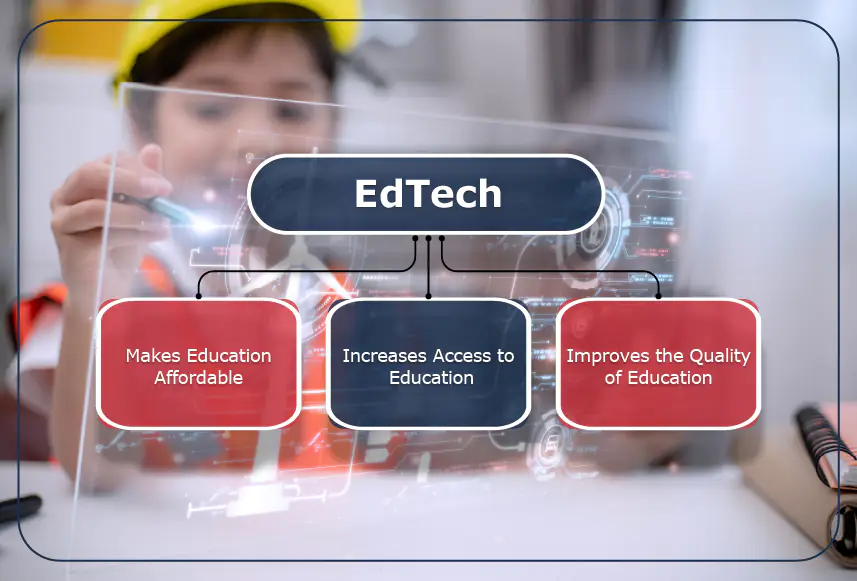
Introduction
EdTech solutions have proved to be quite effective in customizing learning for students, increasing student-teacher collaboration, enabling institutions to enter the future of education, and improving learning and teaching experiences. While there are several benefits offered by EdTech, do you know it can also help overcome financial problems in universities and colleges?
The financial crisis in the education ecosystem is a pressing issue that needs to be addressed urgently. With tuition rates rising and student debt at an all-time high, something tangible needs to be done to make education in Higher Education more affordable. And this is where EdTech solutions come to the rescue.
EdTech is essential to addressing financial problems in education through different means such as making education more accessible. Thanks to digitalization, it offers a set of benefits to both learners and teachers. Digital transformation is certainly the need of the hour for universities and colleges.
In this blog post, we will learn about the financial crisis in education, its impact on the education ecosystem, and how we can solve financial problems in universities and colleges using EdTech.
What are the Financial Problems in Universities?
Before jumping to EdTech solutions, it is better to have a good understanding of the financial problems in universities and colleges.
The #EducationSystem Has Expanded To A Size Unprecedented In History, But A Crisis Of Similar Proportion Has Affected The System’s Ability To Operate. This Crisis Is #Financial, And It Is A Complex Issue Having Several Folds To It.
In this section, we will discuss a few factors contributing to the financial problems in universities.
1. Burden of Student Loans
Student loan debt is a serious financial burden that not only weighs down individuals obtaining education but also the global economy. In recent years, tuition fees have been increasing at high rates, which has forced students to borrow loans to finance their education.
Many graduates struggle to repay their loans while trying to support themselves financially. Default rates on federal student loans have risen sharply over the past decade. Reducing this burden will require a concerted effort from policymakers, educators, lenders, employers, and individuals.

2. Decrease in Public Funding
One major factor that triggers financial problems in universities is the decreasing public funding for higher education. With state and local governments facing budget constraints in recent years, they have largely shifted the responsibility of funding universities and colleges to students and their families through higher tuition prices.
Another significant factor to consider is the hiring of more administrators and staff members by educational institutions, while simultaneously reducing teaching positions.
Furthermore, as universities and colleges compete for students in an increasingly competitive market, they are spending more funds on amenities such as fancy dormitories and recreation facilities. Instead, they can consider investing in core academic programs and EdTech solutions that can:
- Offer students better learning experiences
- Prepare them to compete in the current talent/job market
- Educate and train them for the skills of the future
3. High Cost of Tuition
In recent years, tuition has been increasing faster than inflation, making it more difficult for students and their families to afford education.
For years, the tuition cost has been increasing faster than the inflation rate, making it difficult for families to pay for college. Another major cause of the financial crisis in education is the decrease in state funding for universities and colleges. In many states, budgets have been cut down, leading to a reduction in funding for Higher Education.
What is the Impact of the Financial Crisis on the Education Ecosystem?
The financial trouble in education has resulted in a learning crisis, impacting both learners and their societies. Insufficient funding and investments in universities and colleges compromise the quality of education and educational resources.
Financial problems in universities and colleges not only affect learners and educators but also act as a potential obstacle in building a sustainable future of education. This is because educational institutions are forced to cut back on their budgets, leading to a decline in the quality of instructors and facilities for students.

How can EdTech Solutions Help Overcome Financial Problems in Universities?
So far, we have discussed the financial crisis in education. Now it’s time to learn how this crisis can be addressed and the financial problems in universities and colleges be resolved.
Thanks to EdTech solutions, we can retain the balance of the education ecosystem. EdTech makes education more affordable and accessible to learners. Today, more people can obtain education than before using EdTech platforms.
Investing in EdTech solutions offers well-documented long-run benefits for educators, universities and colleges, and learners. We must reimagine education, transform learning outcomes, and unlock the potential of digital technology using EdTech for current and future generations.
EdTech solutions help universities and colleges deliver learners a better and personalized learning experience and equip educators with new resources. Thus, let’s move forward and discuss EdTech solutions for solving financial problems from university’s perspective and student’s perspective.
EdTech Solutions: From the Perspective of Universities
EdTech makes education more affordable and accessible to learners. More people can gain education using EdTech platforms than before. Investing in EdTech offers well-documented long-run benefits for educators, universities/colleges, and learners. We must reimagine education, transform learning outcomes, and unlock the potential of the next generation. EdTech and digital technologies help universities deliver learners a better and personalized learning experience and equip educators with new materials that could help both faculties and learners.
Universities can essentially encourage students to enroll and thus witness a significant increase in enrolments. Moreover, universities can cut some of the costs using automation and choose to cut down the cost on subscriptions. With the help of emerging technologies, universities can automate a few workflows such as:
- Financial aid requests
- Grant proposal processes
- Staff and faculty onboarding
- Admissions applications
- Transcript requests
- Internship applications
- Payment disbursement requests
- Student scheduling
- Scholarship awards
- Scholarship applications
Moving forward to our next sub-section. Let’s dive deeper into education technology solving the financial crisis from student’s point of view.
EdTech Solutions: From the Perspective of Students

1. EdTech is Making Education Affordable
EdTech platforms can offer free to low-cost online courses. This allows people to afford the education fees. There are many websites and apps that provide free to low-cost educational resources supplementing or even replacing traditional textbooks and other learning materials.
Universities and colleges also leverage EdTech solutions to offer online courses and programs. This can be a more affordable option for students, as they don’t need to pay for transportation and on-campus accommodation. Additionally, online programs offer flexible schedules that allow students to work around their existing commitments.
2. EdTech is Increasing Access to Education
In addition to making education more affordable, EdTech is increasing access to education. This is especially important for people who live in rural areas or other places with limited education opportunities.
With EdTech solutions, people can take advantage of online courses and programs from anywhere in the world. Additionally, EdTech solutions can provide people with access to specialized courses and programs that may only be available outside their local area. Such courses can be made available to anyone with an internet connection, regardless of where they live.
3. EdTech is Improving the Quality of Education
With technological advances, educators can create more engaging and interactive learning experiences for students. Data collected from EdTech platforms can personalize instruction and help students learn more effectively.
Some examples of how EdTech solutions are improving the quality of education are:
- VR simulations that give students a real, firsthand experience of different environments or historical periods
- Adaptive learning software that adjusts content based on each student’s needs
- Digital portfolios that give students a chance to showcase their work professionally
Want to learn more about how EdTech solutions help universities overcome financial obstacles? Do you know how to pursue financial stability through technological innovation? Are you aware of the three EdTech solutions that stand out as standard among rapidly growing universities and colleges?
End Note
We cannot solve the financial problems in universities overnight. However, with the help of EdTech solutions and digitalization, we can surely take solid steps to solve them. With EdTech, we can work together to ensure everyone has access to high-quality and affordable education.
EdTech is a solution that makes education more affordable and accessible and improves the quality of education. This benefits both students and educational institutions like universities. With the cost of tuition rising and public funding decreasing, EdTech is becoming an increasingly attractive solution for universities looking to cut costs and improve educational outcomes.
If you are looking to solve financial problems in your university with modern EdTech solutions or need an EdTech expert, reach out to us at contact@harbingergroup.com.





